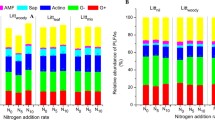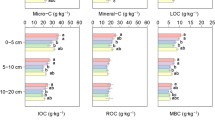Abstract
Canada bluejoint grass [Calamagrostis canadensis (Michx.) Beauv., referred to as bluejoint below] is a competitive understory species widely distributed in the boreal region in North America and builds up a thick litter layer that alters the soil surface microclimate in heavily infested sites. This study examined the effects of understory removal, N fertilization, and litter layer removal on litter decomposition, soil microbial biomass N (MBN), and net N mineralization and nitrification rates in LFH (the sum of organic horizons of litter, partially decomposed litter and humus on the soil surface) and mineral soil (0–10 cm) in a 13-year-old white spruce [Picea glauca (Moench.) Voss] plantation infested with bluejoint in Alberta, Canada. Removal of the understory vegetation and the litter layer together significantly increased soil temperature at 10 cm below the mineral soil surface by 1.7 and 1.3°C in summer 2003 and 2004, respectively, resulting in increased net N mineralization (by 1.09 and 0.14 mg N kg−1 day−1 in LFH and mineral soil, respectively, in 2004) and net nitrification rates (by 0.10 and 0.20 mg N kg−1 day−1 in LFH and mineral soil, respectively, in 2004). When the understory vegetation was intact, nitrification might have been limited by NH4 + availability due to competition for N from bluejoint and other understory species. Litter layer removal increased litter decomposition rate (percentage mass loss per month) from 2.6 to 3.0% after 15 months of incubation. Nitrogen fertilization did not show consistent effects on soil MBN, but increased net N mineralization and nitrification rates as well as available N concentrations in the soil. Clearly, understory removal combined with N fertilization was most effective in increasing rates of litter decomposition, net N mineralization and nitrification, and soil N availability. The management of understory vegetation dominated by bluejoint in the boreal region should consider the strong effects of understory competition and the accumulated litter layer on soil N cycling and the implications for forest management.








Similar content being viewed by others
References
Aerts R (1997) Climate, leaf litter chemistry and leaf litter decomposition in terrestrial ecosystems: a triangular relationship. Oikos 79:439–449
Beckingham JD, Corns IGW, Archibald JH (1996) Field guide to the eco-sites of west-central Alberta. Canadian Forest Service, Special Report, 9th edn. Northern Forestry Centre, Edmonton
Bell FW, Ter-Mikaelian MT, Wagner RG (2000) Relative competitiveness of nine early-successional boreal forest species associated with planted jack pine and black spruce seedlings. Can J For Res 30:790–800
Berg B, Meentemeyer V (2002) Litter quality in a north European transect versus carbon storage potential. Plant Soil 242:83–92
Binkley D, Hart SC (1989) The components of nitrogen availability assessments in forest soils. Adv Soil Sci 10:57–112
Bodelier PLE, Duyts H, Blom CWPM, Laanbroek HJ (1998) Interactions between nitrifying and denitrifying bacteria in gnotobiotic microcosms planted with the emergent macrophyte Glyceria maxima. FEMS Microbiol Ecol 25:63–78
Booth MS, Stark JM, Caldwell MM (2003) Inorganic N turnover and availability in annual- and perennial-dominated soils in a northern Utah shrub-steppe ecosystem. Biogeochemistry 66:311–330
Busse MD, Cochran PH, Barren JW (1996) Changes in ponderosa pine site productivity following removal of understory vegetation. Soil Sci Soc Am J 60:1614–1621
Campbell RA (1991) Silvicultural herbicides in Canada: registration status and research trends. For Chron 67:520–527
Chang SX, Preston CM, Weetman GF (1995) Soil microbial biomass and microbial and mineralizable N in a clear-cut chronosequence on northern Vancouver Island, British Columbia. Can J For Res 25:1595–1607
Compton JE, Watrud LS, Porteous LA, DeGrood S (2004) Response of soil microbial biomass and community composition to chronic nitrogen additions at Harvard forest. For Ecol Manage 196:143–158
Conn JS, Deck RE (1991) Canada blue-joint grass (Calamagrostis canadensis) control with glyphosate and additives. Weed Technol 5:521–524
Doane TA, Horwath WR (2003) Spectrophotometric determination of nitrate with a single reagent. Anal Lett 36:2713–2722
Ecological Stratification Working Group (1996) A national ecological framework for Canada. Centre for Land and Biological Resources Research, Agriculture and Agri-Food Canada and State of Environment Directorate, Environment Canada, Ottawa, p 125
Eis S (1981) Effect of vegetative competition on regeneration of white spruce. Can J For Res 11:1–8
Eno CF (1960) Nitrate production in the field by incubating the soil in polyethylene bags. Soil Sci Soc Am Proc 24:277–279
Environment Canada (2004a) Canadian Climate Normals 1971–2000 (online). Available from http://www.climate.weatheroffice.ec.gc.ca/climate_normals/ (accessed on 9/24/2006)
Environment Canada (2004b) Climate Data Online (online). Available from http://www.climate.weatheroffice.ec.gc.ca/climateData/canada_e.html (accessed on 9/24/2006)
Fisk MC, Fahey TJ (2001) Microbial biomass and nitrogen-cycling responses to fertilization and litter removal in young northern hardwood forests. Biogeochemistry 53:201–223
Fog K (1988) The effect of added nitrogen on the rate of decomposition of organic-matter. Biol Rev Camb Philos Soc 63:433–462
Goodman LF, Hungate BA (2006) Managing forests infested by spruce beetles in south-central Alaska: effects on nitrogen availability, understory biomass, and spruce regeneration. For Ecol Manage 227:267274
Gordon A, Tallas M, Van Cleve K (1987) Soil incubations in polyethylene bags: effect of bag thickness and temperature on nitrogen transformations and CO2 permeability. Can J Soil Sci 67:65–75
Gurlevik N, Kelting DL, Allen HL (2004) Nitrogen mineralization following vegetation control and fertilization in a 14-year-old loblolly pine plantation. Soil Sci Soc Am J 68:272–281
Hangs RD, Knight JD, Van Rees KCJ (2002) Interspecific competition for nitrogen between early successional species and planted white spruce and jack pine seedlings. Can J For Res 32:1813–1821
Hangs RD, Knight JD, Van Rees KCJ (2003) Nitrogen uptake characteristics for roots of conifer seedlings and common boreal forest competitor species. Can J For Res 33:156–163
Hart SC, Stark JM (1997) Nitrogen limitation of the microbial biomass in an old-growth forest soil. Ecoscience 4:91–98
Hogg EH, Lieffers VJ (1991) The impact of Calamagrostis canadensis on soil thermal regimes after logging in northern Alberta. Can J For Res 21:387–394
Houston APC, Visser S, Lautenschlager RA (1998) Response of microbial processes and fungal community structure to vegetation management in mixedwood forest soils. Can J Bot 76:2002–2010
Iglewicz B, Hoaglin DC (1993) How to detect and handle outliers. ASQC basic references in quality control, vol 16. ASQC Quality Press, Milwaukee, p 87
Kaye JP, Hart SC (1997) Competition for nitrogen between plants and soil microorganisms. Trends Ecol Evol 12:139–143
Kimmins JP (1996) Importance of soil quality and conifer growth to silvicultural treatments. Soil Sci Soc Am J 60:1643–1654
Köchy M, Wilson SD (1997) Litter decomposition and nitrogen dynamics in aspen forest and mixed-grass prairie. Ecology 78:732–739
Ländhausser SM, Lieffers VJ (1998) Growth of Populus tremuloides in association with Calamagrostis canadensis. Can J For Res 28:396401
Lavoie M, Bradley RL (2003) Short-term increases in relative nitrification rates due to trenching in forest floor and mineral soil horizons of different forest types. Plant Soil 252:367–384
Li QC, Allen HL, Wilson CA (2003) Nitrogen mineralization dynamics following the establishment of a loblolly pine plantation. Can J For Res 33:364–374
Lieffers VJ, Macdonald SE, Hogg EH (1993) Ecology of and control strategies for Calamagrostis canadensis in boreal forest sites. Can J For Res 23:2070–2077
Matsushima M, Chang SX (2006) Vector analysis of understory competition, N fertilization, and litter layer removal effects on white spruce growth and nutrition in a 13-year-old plantation. For Ecol Manage 236:332–341
Mulvaney RL (1996) Chapter 38. Nitrogen-inorganic forms. In: SSSA book series: 5. Methods of soil analysis. Part 3—chemical methods. Madison p 1123
Ohtonen R, Munson A, Brand D (1992) Soil microbial community response to silvicultural intervention in coniferous plantation ecosystems. Ecol Appl 2:363–375
Olson JS (1963) Energy storage and the balance of producers and decomposers in ecological systems. Ecology 44:322–331
Perie C, Munson AD (2000) Ten-year responses of soil quality and conifer growth to silvicultural treatments. Soil Sci Soc Am J 64:1815–1826
Reynolds PE, Thevathasan NV, Simpson JA, Gordon AM, Lautenschlager RA, Bell WF, Gresch DA, Buckley DA (2000) Alternative conifer release treatments affect microclimate and soil nitrogen mineralization. For Ecol Manage 133:115–125
Smith VC, Bradford MA (2003) Litter quality impacts on grassland litter decomposition are differently dependent on soil fauna across time. Appl Soil Ecol 24:197–203
Soil Classification Working Group (1998) The Canadian system of soil classification, 3rd edn. Agriculture and agri-food canada, Ottawa, p 187
Tan X, Chang SX, Kabzems R (2005) Effects of soil compaction and forest floor removal on soil microbial properties and N transformations in a boreal forest long-term soil productivity study. For Ecol Manage 217:158–170
Taylor BR, Parkinson D, Parsons WFJ (1989) Nitrogen and lignin content as predictors of litter decay-rates—a microcosm test. Ecology 70:97–104
The National Atlas of Canada (1974) Average Annual Potential Evapotranspiration, 4th edn (online). Available from http://atlas.gc.ca/site/english/maps/archives/4thedition/environment/climate/049_50 (accessed on 2/2/2005)
Thirukkumaran CM, Parkinson D (2000) Microbial respiration, biomass, metabolic quotient and litter decomposition in a lodgepole pine forest floor amended with nitrogen and phosphorous fertilizers. Soil Biol Biochem 32:59–66
Vance ED, Brookes PC, Jenkinson DS (1987) An extraction method for measuring soil microbial biomass C. Soil Biol Biochem 19:703–707
Wynnyk A, Lindsay JD, Odynsky W (1969) Soil survey of the Whitecourt and Barrhead area. Alberta Soil Survey Report No. 27. Soils Division, Research Council of Alberta, Edmonton
Zak DR, Groffman PM, Pregitzer KS, Christensen S, Tiedje JM (1990) The vernal dam—plant microbe competition for nitrogen in northern hardwood forests. Ecology 71:651–656
Zhong ZK, Makeschin F (2004) Comparison of soil nitrogen dynamics under beech, Norway spruce and Scots pine in central Germany. Eur J For Res 123:29–37
Acknowledgments
Funding for this study was provided by Faculty of Graduate Studies and Research and the Department of Renewable Resources, University of Alberta, Natural Science and Engineering Research Council (NSERC) of Canada, the Canadian Foundation for Innovation (CFI), the Weyerhaeuser Company Ltd, and Weldwood of Canada Ltd. We thank Carmela Arevalo, Dr Woo-Jung Choi, Kirsten Ketilson, Dr He Liang, Peter Presant, Dan Saurette, Xiao Tan, Kaimin Zhan, and Dr Huanchao Zhang, for assistance in the field and/or laboratory. The discussion of Drs Phil Comeau and Vic Lieffers was greatly appreciated. We also thank Dave Swindlehurst, Weyerhaeuser Company Ltd, and Paul Godin, Millar Western Forest Products Ltd, for assistance in site selection and in providing information on site history. Comments from three anonymous reviewers on an earlier version substantially improved this manuscript.
Author information
Authors and Affiliations
Corresponding author
Rights and permissions
About this article
Cite this article
Matsushima, M., Chang, S.X. Effects of understory removal, N fertilization, and litter layer removal on soil N cycling in a 13-year-old white spruce plantation infested with Canada bluejoint grass. Plant Soil 292, 243–258 (2007). https://doi.org/10.1007/s11104-007-9220-x
Received:
Accepted:
Published:
Issue Date:
DOI: https://doi.org/10.1007/s11104-007-9220-x




